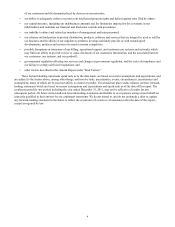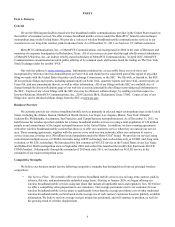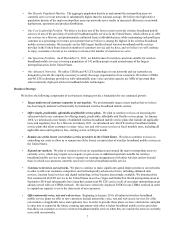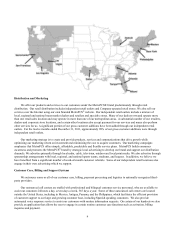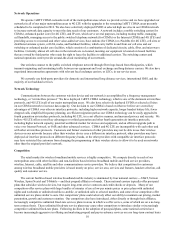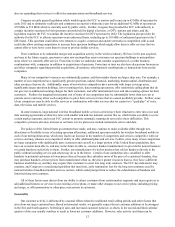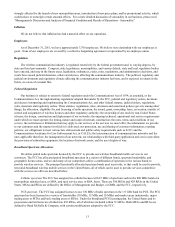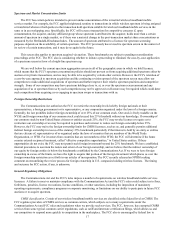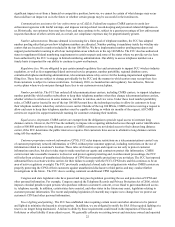Metro PCS 2011 Annual Report Download - page 24
Download and view the complete annual report
Please find page 24 of the 2011 Metro PCS annual report below. You can navigate through the pages in the report by either clicking on the pages listed below, or by using the keyword search tool below to find specific information within the annual report.13
strongly affected by the launch of new metropolitan areas, introduction of new price plans, and by promotional activity, which
could reduce or outweigh certain seasonal effects. For a more detailed discussion of seasonality in our business, please read
“Management's Discussion and Analysis of Financial Condition and Results of Operations - Seasonality.”
Inflation
We do not believe that inflation has had a material effect on our operations.
Employees
As of December 31, 2011, we have approximately 3,700 employees. We believe our relationship with our employees is
good. None of our employees are covered by a collective bargaining agreement or represented by an employee union.
Regulation
The wireless communications industry is regulated extensively by the federal government and, to varying degrees, by
state and local governments. Congress, state legislatures, municipalities, and various federal, state and local regulatory bodies
have enacted, and may in the future enact, legislation, ordinances, codes, rules, regulations, and administrative decisions, and
courts have issued judicial decisions, orders and decrees, affecting the communications industry. The political, regulatory and
judicial environment and regulatory climate affecting the communications industry has been, and is expected to remain in the
future, in a state of constant flux.
Federal Regulation
Our business is subject to extensive federal regulation under the Communications Act of 1934, as amended, or the
Communications Act, the implementing regulations adopted thereunder by the FCC, judicial and regulatory orders, decisions
and decrees interpreting and implementing the Communications Act, and other federal statutes, judicial orders, regulations,
rules, decisions and regulatory orders. These statutes, regulations, rules, decisions and associated policies govern, among other
things, the allocation, eligibility for, and licensing of radio spectrum; the award, grant, ownership, lease, revocation, transfer of
control and assignment of wireless licenses and other regulatory authority; the ownership of our stock by non-United States
citizens; the design, construction and deployment of our networks; the ongoing technical, operational and service requirements
under which we must operate; the timing, nature and scope of network construction; the rates, terms and conditions of our
service; the restrictions or limitations that may apply to our services or the services we must offer; the information we provide
to our customers and the manner in which it is delivered; our protection, use and sharing of customer information; roaming
policies; our obligations to meet various law enforcement and public safety requirements such as E-911 and the
Communications Assistance for Law Enforcement Act, or CALEA; the interconnection of communications networks and the
rates applicable therefore; the management of our network; our relationships with third-party application and service providers;
the provision of subscriber equipment; the location of network assets; and the use of rights of way.
Broadband Spectrum Allocations
We utilize paired radio spectrum licensed by the FCC to provide our wireless broadband mobile services to our
customers. The FCC has allocated paired broadband spectrum in a variety of different bands, spectrum bandwidths, and
geographic license areas, and we and many of our competitors utilize a combination of spectrum in the various bands to
provide wireless services. The principal terrestrially allocated spectrum bands used to provide, or that could be used to provide,
terrestrial broadband wireless mobile services in the United States, all of which can be used to provide services competitive
with the services we offer are described below:
Cellular spectrum. The FCC has assigned two cellular licenses with 25 MHz of spectrum each in the 800 MHz band on a
metropolitan statistical area, or MSA, and rural service area, or RSA, basis. There are 306 MSAs and 428 RSAs in the United
States. MSAs and RSAs are defined by the Office of Management and Budget, or OMB, and the FCC, respectively.
PCS spectrum. The FCC has assigned licenses to use 130 MHz of radio spectrum in the 1.9 GHz band for PCS. The PCS
spectrum has been licensed in a variety of bandwidths (30 MHz, 15 MHz and 10 MHz) and market areas (nationwide, major
trading areas or MTAs and basic trading areas or BTAs). Under the broadband PCS licensing plan, the United States and its
possessions and territories are divided into 493 BTAs, all of which are included within 51 MTAs. Both MTAs and BTAs are
defined by Rand McNally & Company, with certain modifications adopted by the FCC.


